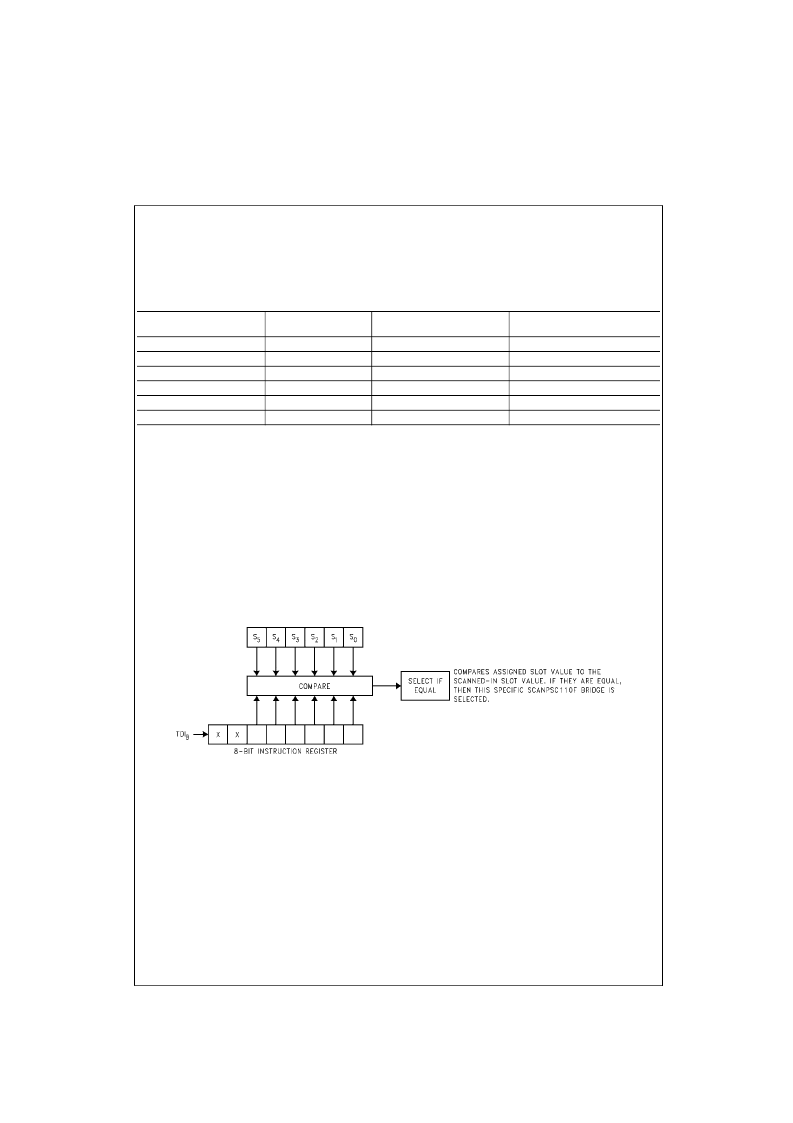- 您現(xiàn)在的位置:買賣IC網(wǎng) > PDF目錄383804 > SCANPSC110FSC (FAIRCHILD SEMICONDUCTOR CORP) SCAN Bridge Hierarchical and Multidrop Addressable JTAG Port (IEEE1149.1 System Test Support) PDF資料下載
參數(shù)資料
| 型號: | SCANPSC110FSC |
| 廠商: | FAIRCHILD SEMICONDUCTOR CORP |
| 元件分類: | 微控制器/微處理器 |
| 英文描述: | SCAN Bridge Hierarchical and Multidrop Addressable JTAG Port (IEEE1149.1 System Test Support) |
| 中文描述: | SPECIALTY MICROPROCESSOR CIRCUIT, PDSO28 |
| 封裝: | 0.300 INCH, MS-013, SOIC-28 |
| 文件頁數(shù): | 9/25頁 |
| 文件大?。?/td> | 283K |
| 代理商: | SCANPSC110FSC |

9
www.fairchildsemi.com
S
Level 1 Protocol
ADDRESSING MODES
The SCANPSC110F Bridge supports
“
single
”
and
“
multi-
ple
”
modes of addressing a SCANPSC110F. The
“
single
”
mode will select one SCANPSC110F and is called Direct
Addressing. More than one SCANPSC110F device can be
selected via the Broadcast and Multi-Cast Addressing
modes.
TABLE 4. SCANPSC110F Bridge Address Modes
Note 2:
Hex address
’
7X
’
,
’
BX
’
, or
’
FX
’
may be used instead of
’
3X
’
.
Note 3:
Only the six (6) LSB
’
s of the address is compared to the S
(0
–
5)
inputs. The two (2) MSB's are
“
don't cares
”
.
DIRECT ADDRESSING
The SCANPSC110F enters the
Wait-For-Address
state
when:
1. its TAP Controller enters the
Test-Logic-Reset
state, or
2. its instruction register is updated with the GOTOWAIT
instruction (while either selected or unselected).
Each SCANPSC110F within a scan network must be stati-
cally configured with a unique address via its S
(0
–
5)
inputs.
While the SCANPSC110F controller is in the
Wait-For-
Address
state, data shifted into bits 5 through 0 of the
instruction register is compared with the address present
on the S
(0
–
5)
inputs in the
Update-IR
state. If the six (6)
LSBs of the instruction register match the address on the
S
(0
–
5)
inputs, (see Figure 6) the SCANPSC110F becomes
selected, and is ready to receive Level 2 Protocol (i.e., fur-
ther instructions). When the SCANPSC110F is selected, its
device identification register is inserted into the active scan
chain.
All SCANPSC110Fs whose S
(0
–
5)
address does not match
the instruction register address become unselected. They
will remain unselected until either their TAP Controller
enters the
Test-Logic-Reset
state, or their instruction regis-
ter is updated with the
GOTOWAIT
instruction.
FIGURE 6. Direct Addressing: Device Address Loaded into Instruction Register
BROADCAST ADDRESSING
The Broadcast Address allows a tester to simultaneously
select all SCANPSC110Fs in a test network. This mode is
useful in testing systems which contain multiple identical
boards. To avoid bus contention between scan-path output
drivers on different boards, each SCANPSC110F
’
s TDO
B
buffer is always 3-stated while in Broadcast mode. In this
configuration, the on-chip Linear Feedback Shift Register
(LFSR) can be used to accumulate a test result signature
for each board that can be read back later by direct-
addressing each board
’
s SCANPSC110F.
MULTI-CAST ADDRESSING
As a way to make the broadcast mechanism more selec-
tive, the SCANPSC110F provides a
“
Multi-cast
”
addressing
mode. A SCANPSC110F's multi-cast group register
(MCGR)
can
be
programmed
SCANPSC110F to one of four (4) Multi-Cast groups. When
SCANPSC110Fs in the
Wait-For-Address
state are
updated with a Multi-Cast address, all SCANPSC110Fs
whose MCGR matches the Multi-Cast group will become
selected. As in Broadcast mode, TDO
B
is always 3-stated
while in Multi-cast mode.
to
assign
that
Address Types
Hex Address
(Note 2)
00 to 3A
3B
3C
3D
3E
3F
Binary Address
(Note 3)
XX000000 to XX111010
XX111011
XX111100
XX111101
XX111110
XX111111
TDO
B
State
Direct Address
Broadcast Address
Multi-Cast Group 0
Multi-Cast Group 1
Multi-Cast Group 2
Multi-Cast Group 3
Normal IEEE Std. 1149.1
Always 3-STATED
Always 3-STATED
Always 3-STATED
Always 3-STATED
Always 3-STATED
相關(guān)PDF資料 |
PDF描述 |
|---|---|
| SCP-5453 | SOCKET,IC,16PIN,MACHINE TOOLED WIRE WRAP,0.3"WIDE,0.515"LEAD |
| SCP-6122 | POWER OPERATIONAL AMPLIFIER |
| SCS152 | HM Series Hermetically Sealed Basic Switch, Single Pole Double Throw Circuitry, 0.5 A at 28 Vdc, Integral Lever Actuator, Solder Termination |
| SCS152-IS | Small glass bead with axial leads |
| SCS152-IW | Small glass bead with axial leads |
相關(guān)代理商/技術(shù)參數(shù) |
參數(shù)描述 |
|---|---|
| SCANPSC110FSCX | 功能描述:特定功能邏輯 SCAN JTAG Port RoHS:否 制造商:Texas Instruments 產(chǎn)品: 系列:SN74ABTH18502A 工作電源電壓:5 V 封裝 / 箱體:LQFP-64 封裝:Tube |
| SCANSTA101 | 制造商:NSC 制造商全稱:National Semiconductor 功能描述:Low Voltage IEEE 1149.1 STA Master |
| SCANSTA101_06 | 制造商:NSC 制造商全稱:National Semiconductor 功能描述:Low Voltage IEEE 1149.1 STA Master |
| SCANSTA101SM | 功能描述:接口 - 專用 RoHS:否 制造商:Texas Instruments 產(chǎn)品類型:1080p60 Image Sensor Receiver 工作電源電壓:1.8 V 電源電流:89 mA 最大功率耗散: 最大工作溫度:+ 85 C 安裝風(fēng)格:SMD/SMT 封裝 / 箱體:BGA-59 |
| SCANSTA101SM/NOPB | 功能描述:接口 - 專用 Low Vltg IEEE 1149.1 Sys Test Access RoHS:否 制造商:Texas Instruments 產(chǎn)品類型:1080p60 Image Sensor Receiver 工作電源電壓:1.8 V 電源電流:89 mA 最大功率耗散: 最大工作溫度:+ 85 C 安裝風(fēng)格:SMD/SMT 封裝 / 箱體:BGA-59 |
發(fā)布緊急采購,3分鐘左右您將得到回復(fù)。